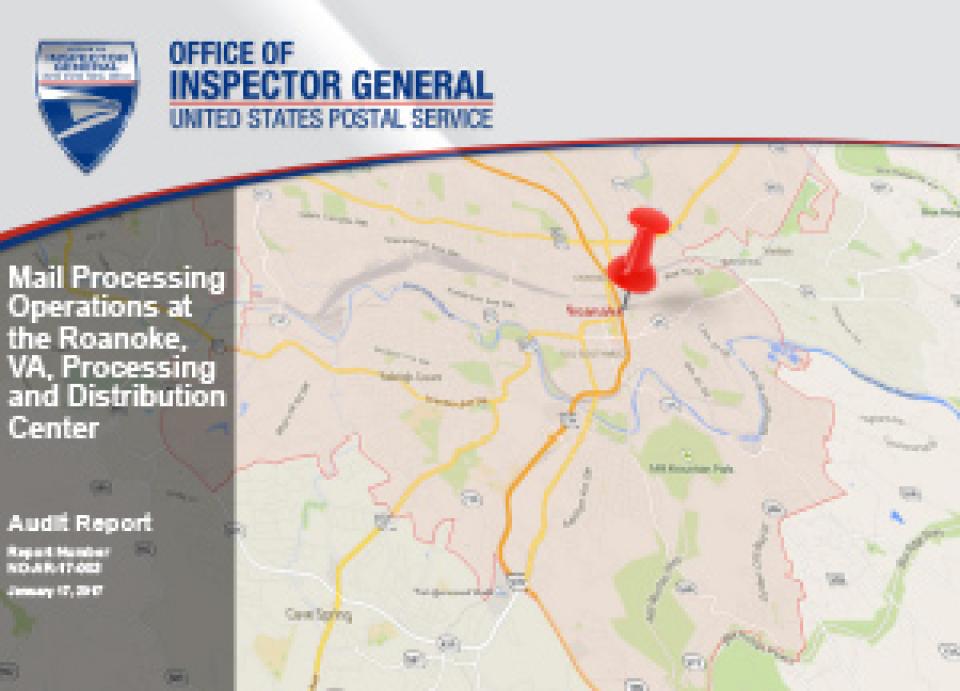Mail Processing Operations at the Roanoke, VA, Processing and Distribution Center
Background
On January 5, 2015, the U.S. Postal Service revised its First-Class Mail® (FCM) service standards nationwide, eliminating single-piece overnight service and shifting some mail from a 2-day to a 3-day service standard. These revisions enabled the Postal Service to expand the amount of time each day that it could process mail, a change known as the operational window change (OWC).
The Postal Service in 1984 began using area mail processing (AMP) policy to consolidate mail processing functions and increase productivity through more efficient use of equipment, facilities, staffing, and transportation. The Postal Service intends for these consolidations to reduce costs and maintain quality service.
In February 2012, Postal Service management approved an AMP feasibility study to move the Roanoke, VA, Processing and Distribution Center (P&DC) originating and destinating (mail sent from and to specific ZIP Codes) letter and flat operations to the Greensboro, NC, P&DC. The originating and destinating package operations were to remain at the Roanoke P&DC.
In April 2015, the Postal Service partially implemented the consolidation by moving all Roanoke P&DC originating letter and flat operations to the Greensboro P&DC. In May 2015, the Postal Service suspended all AMP consolidations.
This report responds to requests from U.S. Representatives Bob Goodlatte and H. Morgan Griffith of the 6th and 9th congressional districts of VA, respectively, to review the consolidation. The lawmakers’ requests noted that they had received a significant increase in constituent communications regarding lost or delayed mail in their respective congressional districts.
Our objectives were to determine whether consolidation of Roanoke P&DC mail processing operations into the Greensboro P&DC adversely affected customer service and whether a business case existed to support the AMP consolidation. As part of the audit, we solicited input from the readers of our Audit Asks web page about their mail service in southwest Virginia.
What the OIG Found
We determined the partial consolidation of Roanoke P&DC mail processing operations into the Greensboro P&DC did not adversely affect customer service scores and a business case existed to support the AMP consolidation.
However, we received comments from over 500 individual respondents to our Audit Asks web page with about 80 percent related to delayed or lost mail and 20 percent related to delivery and similar issues. The complaints were consistent with the mail service issues in the Roanoke, VA, area. Specifically, the FCM service scores for the Roanoke P&DC have been continually below target goals before and after the partial consolidation.
The partial consolidation and nationwide FCM service standard revisions generally resulted in reductions in service standards for mail originating and destinating in ZIP Codes beginning with 240, 241, and 243. Specifically, service standards increased by 1 to 2 days for FCM, Periodicals, Standard Mail, and Package Services affecting over 300,000 delivery addresses serviced by the Roanoke P&DC.
Overall, we found that the Roanoke P&DC FCM service scores as measured against these new standards were largely unchanged after the partial consolidation compared to scores from the same period a year earlier. However, we found some specific periods of time with more significant service issues.
Specifically, from January through March 2016, the 2-day and 3-5 day FCM service scores worsened by 4 and 7 percent, respectively, compared to the same period in 2014 due to severe winter weather. Additionally, for the period October 2015 through September 2016, the Roanoke and Greensboro P&DCs reported 8.6 million pieces of delayed mail — almost a 98 percent increase compared to the same period a year earlier. Delayed mail volume for both P&DCs spiked to 4.5 million pieces in January 2016 due to weather issues.
Service performance rebounded in the following quarter, April through June 2016. In that quarter, FCM service performance for Roanoke’s 2-day and 3-5 day scores were 0.45 and 4.65 percent better, respectively, than the period before the partial consolidation and there was less delayed mail than in FYs 2014 and 2015.
In addition to reviewing service scores, we also looked for delayed mail that may have been miscounted. During our visit to the Greensboro P&DC in August 2016, we identified 104 trays of delayed mail that were not included in the daily mail count. Greensboro P&DC management took immediate corrective action by including the mail in the daily mail count. Inaccurate reporting of mail volume and delayed mail affect management’s ability to accurately plan, analyze, and forecast.
Finally, we were not able to validate $1.3 million of transportation savings included in the AMP feasibility study. However, this did not adversely affect the business case for the consolidation.
We will be performing additional audit work in the future on areas with ongoing mail service issues and delayed mail reporting.
What the OIG Recommended
We recommended management train Greensboro P&DC employees to count all delayed mail and ensure it is correctly reported on the daily mail condition report and re-evaluate transportation savings in the Roanoke P&DC AMP feasibility study.

